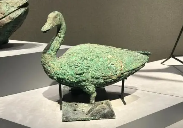Lacquer Ware Medical Historical Research in Changzhi, China
A fascinating archaeological discovery in Changzhi, a city located in central Shanxi province of China, has provided invaluable insights into the ancient practice of using lacquer ware for medical purposes during the Zhou Dynasty (1046–256 BCE). A team of Chinese and international archaeologists led by Dr. Zhao Qiang from Peking University’s Department of Archaeology has unearthed an array of lacquer wares, some with medicinal residue still present, offering a glimpse into the sophisticated healthcare practices of the past.

During excavations at a well-preserved ancient settlement, researchers discovered several lacquer vessels and boxes that had been used to store and transport traditional herbal medicines. These findings shed light on the extensive use of lacquer in traditional Chinese medicine, particularly during periods when wood was scarce and other materials were not as durable or easily obtainable. Some of the vessels even contain evidence of compounds commonly used to treat various illnesses and injuries.
One notable discovery is a set of lacquerware inscribed with detailed records of treatments applied during epidemics and wars. These records, written in Classical Chinese and recently translated, reveal a wealth of information about the medicinal practices of ancient China. They include formulas for poultices, tonics, and even surgical tools made from lacquer. For instance, one record details a lacquer-based salve used to treat burns, showcasing the versatility and effectiveness of lacquer as a material in medicine.
The project has gained widespread attention among scholars and historians worldwide. Dr. Zhao, who has been leading the team since its inception in 2021, commented, “This discovery not only adds another chapter to our understanding of traditional Chinese medicine but also highlights the innovative use of materials and the ingenuity of ancient medical practitioners.” Dr. Zhao emphasized the interdisciplinary nature of the study, involving archaeologists, chemists, historians, and medical professionals from universities across China and the globe.
The collaboration includes renowned institutions such as Peking University, which is contributing significant expertise in the fields of chemistry and historical studies. Other participating universities have provided resources for analyzing the residues found in the lacquer vessels, yielding valuable data about the types of herbs and substances used in the past.
While much work remains to be done, these discoveries provide a compelling glimpse into a largely unexplored aspect of ancient medical practices. The findings promise to enrich our knowledge of both the historical significance of lacquer in daily life and the intricate traditions of Chinese medical knowledge passed down through generations.
 LongStory.Asia The Digital Archaeological Portal
LongStory.Asia The Digital Archaeological Portal